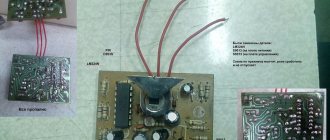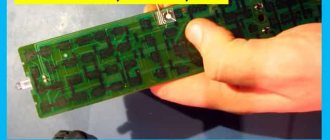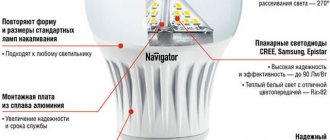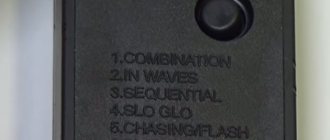Operating principle of LED spotlight
Floodlight with LEDs – an LED device for illuminating an area, a powerful light source. Inside its plastic or iron body there is a lamp that sends light forward. There are reflectors around that direct the lighting to the desired area. They are able to concentrate light in a special way, as intended by the design, and as a result it turns out bright and saturated.
A diode spotlight also consists of a semiconductor and two electrodes - an anode and a cathode. After applying voltage, the semiconductor heats up, which emits light. For high-quality operation of the system, the incoming current passes through a rectifier and driver, which stabilize the electrical wave and regulate its magnitude.
The circuit contains a power supply that requires 12 volts for operation.
Causes of flickering
Among the main reasons that provoke spontaneous flickering are: a special illumination mode of the spotlight, the presence of a switch with built-in backlight, false alarms from a motion sensor, incorrect connection of phase wires, and others. Let's look at each problem in more detail.
1. Glow mode. The most common reason why a spotlight lights up every second is the presence of an appropriate mode in the lighting fixture. Perhaps you simply activated it carelessly. We recommend turning the spotlight on and off several times and observing whether there are any changes. Manufacturers often save on materials and provide several operating modes for the same button. Perhaps when you press the power button again, that same stroboscopic effect is activated.
2. Illuminated switch. Often, for the convenience of users, street lighting systems are connected to a switch in the house. However, if your spotlight is connected to a switch with a built-in backlight, you may experience frequent flashing at certain intervals.
The fact is that such a switch is also equipped with a low-power LED, and even when the light is turned off, the circuit is not completely interrupted (so that this diode can work constantly). Two wires with an insulator between them create something like a capacitor, which in alternating current is a kind of conductor and rectifier. The potential of this current and voltage is just enough to start the LED lamp, but they are clearly not enough for long-term operation. So it turns out that the spotlight flickers at a certain frequency, to the delight of you and your neighbors. The same thing, by the way, is observed in the case of using fluorescent lamps. Replacing the switch with a regular one, without backlight, helps solve the problem. You can also simply de-energize the built-in diode by disconnecting it from the power wires. Also, in order to definitely eliminate the problem, it is recommended to install a capacitor (0.1 - 0.5 µF) or a resistor (50 kOhm, 2 W) in the circuit. They can be located in the distribution box or in the switch socket. The installation diagram will look like this:
3. Is there a problem with the sensor? It is possible that the reason for the strange flickering lies in the motion sensor connected to the spotlight. The most common mistake is when they try to equip LED spotlights with an inappropriate motion sensor - for example, one designed for connecting incandescent lamps. As a result, the LED lamp either stops lighting at all when turned on, or blinks (constantly shines dimly).
This is because the motion sensor requires a certain amount of energy to operate, even when it is in an inactive state. And again, this energy potential, “wandering” through the circuit, is enough to turn on the LED spotlight for a short time.
For an incandescent lamp, these currents are insignificant, it does not light up, but such motion sensors are not suitable for LEDs - for the reasons described above. It is also possible that all the elements are incorrectly connected in the circuit. The correct connection diagram is shown below:
To simplify the choice, today many street lamps are sold together with motion sensors that are most suitable for them in terms of current-voltage characteristics. Models with motion sensors already built into the board are also offered, but it is clear that their cost will be much higher.
However, for illuminating large areas, such combined systems will not be the best choice, since several multidirectional spotlights can be connected to a separate motion sensor at once, which will more fully illuminate the space.
4. Incorrect wire connection. Frequent blinking is caused by incorrect connection of wires when installing the switch. According to the rules, zero must go to the lamp, and the phase must be interrupted by a switch. Otherwise, even when turned off, the lamp will be constantly energized. And then it’s not just a question of discomfort, but also your safety, because... This is contrary to the standards for installing lighting systems.
5. Other reasons But what to do if all possible causes seem to have been eliminated - but the lamps stubbornly continue to blink? In some cases, spontaneous flickering is provoked by the so-called induced voltage. Sometimes it occurs when several wires (both main and switch) are located in one groove at once. And since LED systems require minimal currents to operate, the potential generated is quite enough to start the lamp. In this case, again, a resistor with a power of at least 1 W is useful. Many users note that some lamps light up spontaneously, while others do not - under equal connection conditions. This is explained by the fact that expensive lamps use higher quality ballast, which either extinguishes stray currents, or the soft start unit built into them prevents the lamps from lighting up. Also, to reduce the cost of the design, careless manufacturers exclude capacitors from the circuit and deliberately increase the currents so that the spotlight shines brighter. However, this causes the matrix to constantly overheat, individual lines of diodes begin to burn out, and soon the entire matrix fails. Another factor that should always be taken into account for street lighting systems is the influence of the environment. So, at too low (or vice versa, high) temperatures, the LED spotlight may begin to work incorrectly - flicker or shine too dimly. As a rule, again, it’s not the diodes themselves that are to blame (since the crystals can withstand changes from -70 to +50 ˚С), but the electronic ballast. Drivers - voltage stabilizers warm up (or cool down) unevenly. Because of this, the lamp takes a long time to start when turned on, at first only individual diodes light up, and flickering is observed even after turning off.
Signs of blinking
When buying the cheapest spotlight, you cannot be sure of its uninterrupted operation. Such products usually have poor soldering of parts, all elements are of poor quality, and current parameters are not sufficiently adjusted.
Imported LED devices are sometimes made without taking into account the specifics of power fluctuations, which can also cause breakdowns. The most common complaint from users is the blinking of the lamp; this often happens not only when it is on, but also when it is off. There can be a lot of reasons.
Spotlight flashes due to motion sensor
Why does lighting equipment that has a motion sensor blink? First of all, it is worth checking the operation of the sensor itself; often the reason is hidden in it. If the luminous flux flickers when supplied, the main reasons are as follows:
- Violation of sensor settings. Flashing is often observed due to an incorrectly set timer, which helps maintain the system in working order during the specified period. You should reconfigure the timer and then test the device.
- Faulty contacts, “floating” contact. This is observed when the sensor operates normally, but the signal does not pass through to the spotlight itself. You should check the correctness of all connections in the system, tighten wires and contacts, and evaluate the reliability of terminals and screws.
- Low voltage. When the sensor is constantly under insufficient voltage, it passes to the spotlight, but cannot turn on the device fully. This does not cause full inclusion, but flickering.
- Sensor failure or initial malfunction. If the product is still under warranty, you will have to return it to the store. Otherwise, you should take the motion sensor to a workshop; you cannot repair it yourself.
The reason for blinking is weather conditions
If it is frosty outside, the LED spotlight may light up in an abnormal mode - blink. This often happens even with high-quality products from popular manufacturers. The reason is “frostbite” of any component of the lamp start-up, that is, icing of the elements. Some models begin to blink already at -10 degrees, although the technical parameters indicate the possibility of working at -50...+50 degrees.
Typically, this temperature regime is noted for other elements, but not for the LED itself. The trigger mechanism in the LED spotlight cannot cope with low temperatures, the controller or capacitor freezes. The issue can be resolved this way: periodically bring the spotlight into the house during the day, and then put it in its proper place at night.
The spotlight flashes when turned on
When the device starts to blink when turned on, the reason is most often due to damage to the starting LED capacitor. After replacing it, the system starts working properly. Flickering can also be associated with poor contact or broken wires. In such a situation, check the cables and eliminate the fault.
The spotlight flashes when turned off
This happens when a backlit mechanism is used to turn it on and off. Due to the backlight, a small amount of current flows to the LED spotlight. This causes a flickering effect. If you want to eliminate this phenomenon, you will have to connect the backlight directly or place an incandescent lamp in the path of the current. The latter will draw electricity onto itself.
Spotlight mode
Expensive floodlight models have various additional functions. One of the popular ones is the glow mode, and blinking can be the result of its accidental activation. You should completely turn off the device, then turn it on, assessing whether this phenomenon has disappeared or not.
Another reason is the design feature of the spotlight, where one button activates several functions. This usually happens when the manufacturer decides to save on materials. When pressed twice, the strobe mode is activated - repeating fast light pulses.
Lighting in the switch
To design lighting in a cottage or private house, backlit switches are often purchased, which are designed to ensure the operation of the spotlight. It is the switch that provokes the blinking effect of the spotlight. The main reason is this: the LED does not completely break the circuit, and the insulated wires act as both a conductor, a capacitor, and an AC rectifier. Thus, a low-power LED is not able to ensure efficient operation of the circuit. It is enough to start the lamp, but it is not enough for long-term operation.
The spotlight stopped burning - how to fix it?
First of all, in this situation, you should check whether the device driver is receiving power with a voltage of 220 V. If this is all right, you should first diagnose and repair the driver. It can be checked without connecting an LED by applying electric current to the input. If the device is working correctly, measuring the output with a multimeter should show a DC voltage that will be slightly above the rated limit. For example, for a driver with an output voltage of 28-38 volts, when running idle, the multimeter will show
40 volts. This is explained by the fact that an increase in load resistance (due to idle operation) leads to an increase in voltage.
However, this method does not help to accurately check all drivers. There are blocks that, in good condition, will either produce illogical data or will not start at all. In such a situation, a load resistor that simulates the consumption of an LED will help you check the device. It must be selected in accordance with the characteristics of the driver. For example, with a DC output current of 23-35V 600 mA, the resistor resistance should be in the range from 23/0.6 = 38 Ohms to 35/0.6 = 58 Ohms.
If the output voltage with the load resistor connected meets the specifications, the driver operates correctly.
The easiest way to repair an LED floodlight if the driver has failed is to replace this component. You can purchase a suitable model not only in specialized stores, but also on the Internet. For example, Aliexpress offers a wide variety of spare parts, although you need to be very careful there to choose a quality product (sometimes even the sellers themselves have little understanding of the issue). Sometimes suitable drivers can be found from craftsmen who professionally repair floodlights. And if the LED spotlight was made from diodes with your own hands, then understanding its structure and fixing the problem will be even easier than buying or assembling a new one.
How to select a driver if the power of the LED module is unknown
Many hobbyists have situations when it is necessary to work with a spotlight, the power, current and voltage of the LED chip in which are unknown. Accordingly, in such a situation it is more difficult to select a replacement and driver.
Here you need to count the number of diodes in the LED matrix and add up their indicators. Such LED modules use diodes with a voltage of 3 V, a current of 300-330 mA and a power of 1 W. Accordingly, the total matrix voltage is 27 V with a current of 300 mA (when connected in series). Accordingly, a driver with an output voltage of 20-36 V is required for operation.
Let's give an example with a more complex matrix, which consists of two parallel-connected rows of diodes. Each row has a voltage of approximately 30 V with a current of 300 mA. Due to the parallel connection, the driver must have an output of 30 volts and 600 mA.
Reasons for flashing spotlights
To repair the device, you need to accurately determine the cause of the flickering light. It may be related to wiring, malfunction of semiconductors and other components of the device.
Wiring irregularities
Often the cause of flickering is a simple device connection error. When connecting wires, the master may confuse phase and zero. In some situations, the equipment does not work at all, in other cases it begins to blink. Solving the problem is not difficult - you just need to swap the wires.
Infrequent flickering with unequal frequency means a violation of contacts with the cable connection. A high-power LED floodlight is very different from a regular lamp. If there is no tight contact at the junction of the wires, the resistance begins to increase. The wire heats up, and the resulting scale impairs the contact.
From the area of connection to the network to the point where electricity passes to the matrix power driver, intermediate currents appear. This can happen in the junction box, motion sensor, connectors on the power supply, or switch. You will have to check all the elements until the problem is fixed. Next, the wire is stripped and the contact density is restored by soldering.
Presence of semiconductor devices in the circuit
When a switch with a diode backlight or an infrared motion sensor is installed in front of the lamp, light pulsates at a high frequency (up to 25 times/second). This is caused by a change in current strength in the circuit by the passage of a half-wave of alternating voltage. You can fix the problem by turning off the switch backlight LED. Another repair option would be to replace the motion sensor from infrared to ultrasonic, inductive.
Irregularities in the floodlight power circuit
Failures in the device’s power supply system occur frequently, mainly in cheap models. To correct such problems, you need to know the basics of radio engineering or take the device to a repair shop.
Rectifier (diode) bridge
The cheapest LED floodlights often use a single-bridge AC rectifier. It is very different from a conventional two-bridge circuit in quality - it gives a high voltage ripple amplitude. Even installing a smoothing capacitor does not eliminate the ripple, which causes the light to flicker. The solution is to buy high-quality devices with a “classic” two-bridge circuit.
Smoothing capacitor
Installing a transformer will reduce the voltage amplitude to 12 volts, and the polarity of the negative half-wave will change. Installing a smoothing capacitor will allow you to increase the ripple amplitude to 10-15%, which will not be perceived by the human eye. If the capacity of the smoothing capacitor is insufficient, the amplitude will remain above 15% and will appear as a blinking light.
LED installation errors
With a low-quality assembly of the matrix, which is made up of many LED elements, the contact pad often turns out to be poorly soldered. If one of the contacts is broken, the connection of the group of diodes becomes unstable. This provokes blinking. The solution is to re-solder the diodes or submit the device for repair.
Current limiting capacitor
When the spotlight turns on normally, but operates unevenly and blinks, there is a possibility of a breakdown of the current-limiting capacitor. Unscrupulous manufacturers often want to achieve high brightness not through the power of the device, but by connecting a current-limiting capacitor that is not suitable for the driver. You should replace the part with one that has an operating voltage of 400 volts, and the flickering will disappear.
power unit
Sometimes lighting equipment works well after purchase, but after a few months it begins to flicker. This usually happens when there is a problem with the power supply. The service life of the blocks is up to a year. Towards its end, various light defects begin to appear, after which the element breaks completely. You can buy a suitable power supply (take your old one with you, the store will select one suitable according to the parameters). Also, in many cases, a block from a scanner or printer is suitable. You need to check the technical specifications yourself and replace the part.
Eliminating flickering LED spotlights
Sooner or later, every owner of an LED floodlight faces the problem of flickering. The reason for this behavior may be improper operation of electronic components or loss of performance of LEDs. In this section we look at how to repair an LED floodlight with a power of 10 W. This power is most common, and the general design of the devices is similar, so the solution to the problem is universal.
The LED is a matrix of 9 crystals, each of which has a power of 1 W. These crystals are connected in three sequential circuits and filled with phosphor - a substance that converts the received energy into light. A 10 W LED consists of three lines of crystals, which are connected in parallel to the power coming from the driver.
Burning out one of the crystals in the LED will cause it to blink during operation. The nature of blinking can be either periodic, with equal pauses, or chaotic. For various reasons, matrix combustion can lead to a complete shutdown of the LED element, or to the failure of one or two lines of crystals.
Why does the matrix blink or does not light up when it burns out?
The crystals, filled with phosphor, are connected to each other by leads, which in the case of high-quality products are made of gold, and in budget devices - of copper. Heating the matrix and connecting contacts too much causes these filaments to peel off from the crystals. Therefore, the entire matrix or part of it is turned off. After cooling, the thread returns to its original position and work resumes. After reheating to a critical point, the contact is interrupted again and the matrix goes out. This cycle continues endlessly during operation, and to the observer it looks like a flashing lamp. Complete LED failure occurs when one of the filaments overheats so much that it falls off the crystal.
When can a device be repaired - expediency
The price of a quality spotlight is usually high. An experienced technician can disassemble almost any device, even a sealed one, which means it can be repaired. But we must take into account the cost of spare parts and the complexity of repairs.
The power supply most often fails, because only the LED crystals themselves are durable in the device. Finding the perfect block is not easy. Here it is important to take into account all parameters for power and voltage, otherwise there will be consequences for the remaining elements of the device. If the power supply costs more than the spotlight itself, repairs are not advisable. In other cases, you can try to repair the spotlight, having previously calculated the costs.
In order for lighting equipment to work properly for many years, it is better not to use it for too long. It’s not worth leaving it on all night, which wastes a lot of potential. During installation, you must carefully check all connections for bad contacts - this will cause voltage surges. These rules will help make the work of the spotlight long and uninterrupted.
Source
Determining the feasibility of repairs
A new LED floodlight is expensive. If you contact an experienced technician, he will be able to repair even sealed LED systems. However, you should remember that you will have to spend money on components for the device, which can also be expensive. In addition, the cost includes the complexity of the repair.
Most often, power supplies become unusable, but LEDs have a long service life. If you decide to repair a spotlight that blinks on its own, then when choosing a suitable unit, take into account its characteristics. If you select the wrong part, the rest of the system may malfunction. If the cost of the power supply is higher than the price for the spotlight itself, then it is better to refuse repairs. Then it is easier to purchase a new lighting fixture. In other cases, you can try to repair the device yourself.











